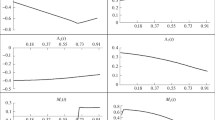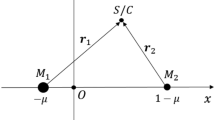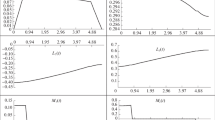Abstract
This paper addresses a single-axis rotation problem in diverse space applications. In the problem, spin-to-spin boundary conditions, a finite jerk constraint, and a fixed final time constraint are considered. The objective is to find a path which maximizes the stabilization period under the given state boundary conditions and path inequality constraints. The optimal control problem is converted into a switching time design problem, and the unknown parameters are calculated analytically by solving the quartic, the cubic, or the quadratic equation. The proposed computational procedures are explained through numerical examples and the closed-form solutions are verified.





Similar content being viewed by others
Data availability
The data used to support this study are available from the corresponding author upon request.
References
Byers RM, Vadali SR, Junkins JL (1990) Near-minimum time, closed-loop slewing of flexible spacecraft. J Guid Control Dyn 13:57–65. https://doi.org/10.2514/3.20517
Eglynas T, Bogdevicius M, Andziulis A, Jusis M (2017) Trolley motion control based on S-shaped velocity profile for quay crane cargo oscillation comparison. Electron Electr Eng 9:283–288. https://doi.org/10.3846/mla.2017.1034
Hecht NK, Junkins JL (1992) Near-minimum-time control of a flexible manipulator. J Guid Control Dyn 15:477–481. https://doi.org/10.2514/3.20860
Miu DK, Bhat SP (1991) Minimum power and minimum jerk position control and its applications in computer disk drives. IEEE Trans Magn 27:4471–4475. https://doi.org/10.1109/20.278666
Lee D, Bang H (2018) Gimbal-angle vectors of the nonredundant CMG cluster. Int J Aero Space Sci 19:443–458. https://doi.org/10.1007/s42405-018-0037-z
Cho D-H, Kim J-H, Choi H-L, Ahn J (2018) Optimization-based scheduling method for agile earth-observing satellite constellation. J Aerosp Inform Syst 15:611–626. https://doi.org/10.2514/1.I010620
Yu T-S, Lee T-E (2019) Scheduling dual-armed cluster tools with chamber cleaning operations. IEEE Trans Automat Sci Eng 16:218–228. https://doi.org/10.1109/TASE.2017.2764105
Zacharia PTh, Aspragathos NA (2005) Optimal robot task scheduling based on genetic algorithms. Robot Comput-Integr Manuf 21:67–79. https://doi.org/10.1016/j.rcim.2004.04.003
Zacharia PTh, **dias E, Aspragathos NA (2013) Task scheduling and motion planning for an industrial manipulator. Robot Comput-Integr Manuf 29:449–462. https://doi.org/10.1016/j.rcim.2013.05.002
Junkins JL, Rahman ZH, Bang H (1991) Near-minimum-time control of distributed parameter systems: analytical and experimental results. J Guid Control Dyn 14:406–415. https://doi.org/10.2514/3.20653
Kim J-J, Agrawal BN (2006) “Experiments on jerk-limited slew maneuvers of a flexible spacecraft,” AIAA Guidance, Navigation, and Control Conference and Exhibit. Keystone, CO. https://doi.org/10.2514/6.2006-6187
Bryson AE Jr, Ho Y-C (1975) Applied optimal control, revised printing. Routledge. https://doi.org/10.1201/9781315137667
Ioslovich I (2003) Arbitrary fuel-optimal attitude maneuvering of a non-symmetric space vehicle in a vehicle-fixed coordinate frame. Automatica 39:557–562. https://doi.org/10.1016/S0005-1098(02)00247-9
Kim BK, Shin KG (1985) Suboptimal control of industrial manipulators with a weighted minimum time-fuel criterion. IEEE Trans Automat Control 30:1–10. https://doi.org/10.1109/TAC.1985.1103783
Liu S-W, Singh T (1997) Fuel/time optimal control of spacecraft maneuvers. J Guid Control Dyn 20:394–397. https://doi.org/10.2514/2.4945
Okubo H, Nagano N, Komatsu N, Tsumura T (1997) Path planning for space manipulators to reduce attitude disturbances. J Guid Control Dyn 20:609–611. https://doi.org/10.2514/2.4086
Lee D, Song Y-J (2019) Spin-to-spin slew maneuvers under spherically constrained angular acceleration. Adv Space Res 64:1274–1285. https://doi.org/10.1016/j.asr.2019.06.026
Kim D, Leeghim H (2019) Near-minimum-fuel strategy for continuous single-axis maneuvers of a rigid body. Trans Jpn Soc Aero Space Sci 62:169–172. https://doi.org/10.2322/tjsass.62.169
Lee D, Song Y-J (2019) Single-axis, spin-to-spin slew maneuvers under a finite jerk constraints. J Guid Control Dyn 42:2116–2123. https://doi.org/10.2514/1.G004351
Singhose W (2009) Command sha** for flexible systems: a review of the first 50 years. Int J Precis Eng Manuf 10:153–168. https://doi.org/10.1007/s12541-009-0084-2
Albassam BA (2002) Optimal near-minimum-time control design for flexible structures. J Guid Control Dyn 25:618–625. https://doi.org/10.2514/2.4945
Mok S-H, Bang H, Lee D (2023) Closed-form solution of attitude command generation for spin-to-spin maneuver. Adv Space Res 71:676–691
Burton DM (2011) The history of mathematics: an introduction, 7th edn. McGraw-Hill, New York, pp 320–331
Polyanin AD, Manzhirov AV (2006) Handbook of mathematics for engineers and scientists. Chapman and Hall/CRC, New York, pp 157–161. https://doi.org/10.1201/9781420010510
Acknowledgements
This work was supported by 2022 Korea Aerospace University Faculty Researchgrant.
Author information
Authors and Affiliations
Corresponding author
Ethics declarations
Conflict of Interest
The authors declare that there are no conflicts of interest regarding the publication of this paper.
Additional information
Publisher's Note
Springer Nature remains neutral with regard to jurisdictional claims in published maps and institutional affiliations.
Appendix
Appendix
1.1 Formula of Quartic Equations
In this Appendix, a formula for the below quartic equation is summarized.
where \(a = 1\). First, a cubic equation is formulated as follows:
where f, g, and h are as follows:
Let \(y_{1}\), \(y_{2}\), and \(y_{3}\) be the roots of the cubic equation in Eq. (A.2), and \(y_{2}\) and \(y_{3}\) be the non-zero roots. Using \(y_{1}\), \(y_{2}\), and \(y_{3}\), the following p, q, r, and s are calculated.
Four roots denoted by \(x_{1}\), \(x_{2}\), \(x_{3}\), and \(x_{4}\) for the quartic equation in Eq. (A.1) are derived as follows:
Rights and permissions
Springer Nature or its licensor (e.g. a society or other partner) holds exclusive rights to this article under a publishing agreement with the author(s) or other rightsholder(s); author self-archiving of the accepted manuscript version of this article is solely governed by the terms of such publishing agreement and applicable law.
About this article
Cite this article
Lee, D., Song, YJ. Closed-Form Solutions for Single-Axis Slew Maneuvers Under a Fixed Final Time Constraint. Int. J. Aeronaut. Space Sci. 25, 635–646 (2024). https://doi.org/10.1007/s42405-023-00682-5
Received:
Revised:
Accepted:
Published:
Issue Date:
DOI: https://doi.org/10.1007/s42405-023-00682-5




